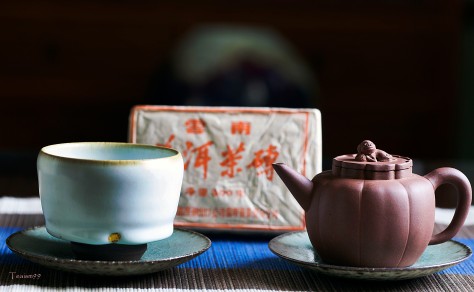
Pu’er tea is generally a compressed tea that comes in many different shapes and sizes. They are also available in dry leaves loose form called maocha. The compression and shapes are for ease of transportation in the past, when teas were carried by mule caravan from Yunnan to Tibet through the famous Ancient Tea Horse Road 茶馬道.
One of compressed tea shape is the brick Pu’er tea. They are dried tea leaves that were pressed into brick shapes since the ancient times. Brick shaped Puer were explored more widely in the 1960s with the first prototype, Jinggu test brick tea. It was subsequently developed into the tea brick that was popularly known as Cultural Revolution brick tea 文革砖茶.
Perhaps the more sought after ones are those done in early 1970s. Some of them have wonderful jujube and ginseng taste. During that period, there were many research and experiments done on fermenting tea to create shou cha. Some of these brick Pu’er tea has the combination of shou and sheng cha, the 30/70 seems to be popular during the 1970s and 1980s.
Brick shape Pu’er tea comes in many sizes and weight. The usual Cultural Revolution brick tea weight is 250grams. There are also some other sizes like 1kg and 500g.
In early 1990s, there was an unusual batch of brick Pu’er tea which was done in 300g size. This tea is unique because it was over compressed. The tea was very hard and dense. It was not known whether the over compression was intentionally done or not. Although the weight is higher, the 300g brick is much smaller in size than the standard 250g brick size. New wrapper has to be printed for this tea, a smaller wrapper with higher weight indication.
The picture below shows a comparison of size between the 300g and 250g brick tea of almost the same era. The heavier 300g brick tea is obviously much smaller than the 250g tea.

The notion of over compression tea is very interesting from the storage and aging point of view. With higher density and compression, the teas are less susceptible to external environment. It will oxidize rather than ferment in its aging process. From tasting experience, an aged well compressed tea seems to retain a lot of its intrinsic quality and also free from external odours and taste character.
This is one of the many observations and experiences which sets the foundation of my understanding for storing and aging Pu’er tea. There are many ways to store and aged Pu’er tea. All methods have their followers and critics and the topic is fiercely debated often. Eventually, there are too many variables and it is up to each individual to choose their own method of storing and aging their Pu’er teas.
Personally for me, keeping tea away from external environment is important, as I store and age them in warm and humid environment. This is done by sealing all the Pu’er tea. Sealing prevent external odour from affecting the tea. It also prevents the high external moisture from inducing fermentation process whilst allowing the desirable oxidation process to take place.
This 300g brick tea is a wonderfully aged Pu’er tea. Due to its high compression, the aging process is slow and steady. It retains all the character and goodness of the tea. The tea quality was excellent when it was freshly made. With good foundation and proper aging process for more than two decades, it has developed into a very clean, smooth and full bodied with fruity character tea. This is certainly one of my favourite Pu’er tea.




























You must be logged in to post a comment.